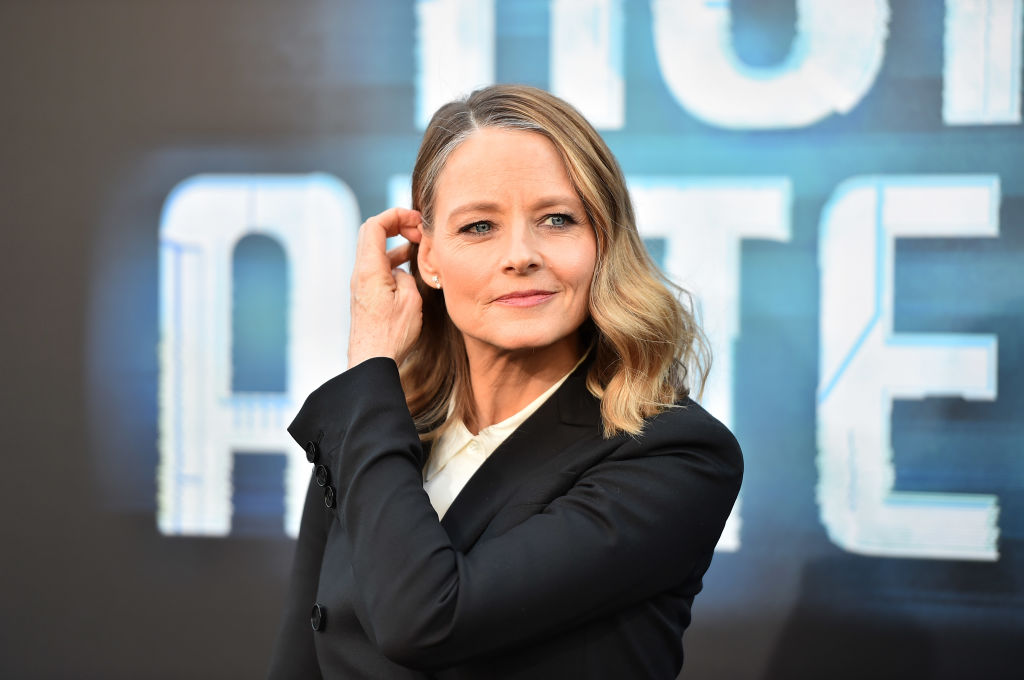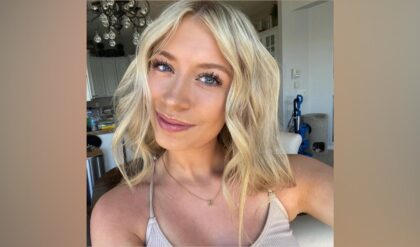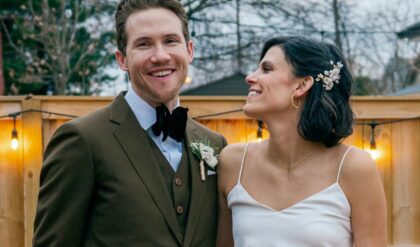The ‘True Detective: Night Country’ star has been an actor since she was 3 years old, and a leading lady for decades. Now, she’s finding fulfillment in supporting and off-camera roles—while still shining when the lights are brightest.
I am Team Tundra, just in case you’re wondering,” Jodie Foster declares over Zoom in December. We are speaking about her latest project, True Detective: Night Country, which premieres January 14 on HBO. But while the show is indeed an ice-cold murder mystery set in the northernmost reaches of Alaska—a land of frozen caves and shadowy mining concerns and vast white windblown expanses—Foster is referring to the name of her fantasy football team.
“We all love each other,” she says about her league. “All a bunch of ladies over 60, some of them I’ve never met. There’s a lot of smack talk going on right about now.” Sitting on a sofa next to Foster, her True Detective costar Kali Reis pipes up that last winter, while they were shooting the series in Iceland, she felt “really intense envy” about Foster’s hobby. “There’d be some times I’d see her on her phone,” says Reis, 37, mimicking the gestures of a person very merrily absorbed in a mobile device, “and I’m like, ‘Whoa, OK! I gotta get into that.’”
“Thank God I left the alerts off,” Foster says. “Because you go, like, ding ding ding! ‘Oh no! He’s broken his ankle! Oh no! He’s back on!’”
![]()
True Detective is back on, too, in more ways than one. The unsettling unbuddy-cop anthology series that premiered a decade ago and last aired in 2019 is returning for a fourth season, one in which Foster and Reis play Liz Danvers and Evangeline Navarro, tiny-town police officers who are saddled with tumultuous, traumatic histories on both individual and interpersonal levels. Forced to collaborate on a baffling, macabre new investigation, the two women work to uncover other people’s secrets—while trying to avoid unpacking their own.
Developed in consultation with members of northern Alaska’s Indigenous tribes, and engaging deeply with the idiosyncrasies of the region, Night Country is a tightly wound six-episode season that involves activism and mysticism, birth and death, guilt and grief—a sort of House of the Dragon meets Mare of Easttown. Critics have roundly praised the season, appreciating its clarion performances, its chilly ambience, and the ambitious decisions made by the chic, funny director Issa López. And they’ve pointed out that this version is right up there alongside Season 1 of True Detective in quality, both demonstrating the best of what the series has to offer.
For Reis, a former world champion boxer, playing the tough yet vulnerable Navarro is a career breakout. (It’s her third IMDb credit.) For Foster, though, the big breaks took place closer to, oh, a half century ago. She got her first commercial gigs at 3 years old. She was a Disney fixture throughout her youth and later a bona fide leading lady. She earned two Oscars and two additional nominations; she has worked with names like Scorsese and Demme and Fincher and Spike. She’s directed numerous prestige TV episodes and full-length feature films. And True Detective: Night Country isn’t even the only work she’s currently out in the world promoting; there’s also the recent swimming biopic Nyad, for which she rocked one hell of a bandanna and biceps combination and has been nominated for multiple supporting actress awards.
It feels a little bit like old times: Foster with multiple concurrent projects, same as it ever was. But there’s a key difference: Now in her sixth decade of life, Foster has already mastered being the lead actress. These days, she’s more motivated by nailing the whole “supporting” part of things. “It feels like there’s something really of a relief and also satisfying,” she tells me, “about saying: It was my time, it’s not my time anymore. I had my time, and it’s someone else’s time now.” It’s a sentiment that is both beautiful and also a teensy bit absurd, because anyone who watches Foster’s work can plainly see that her time is still, all these years later, decidedly now.
InIn True Detective: Night Country, Danvers (Foster) and Navarro (Reis) stomp through snow and riffle through evidence and revisit a cold case in the hopes of uncovering a lead on their gruesome new assignment. (Reader, a severed tongue and clawed-out eyes are involved.) They hunt for clues as they are haunted by the dead. They bang local (and sometimes from faraway Fairbanks) dudes, pilfering a SpongeBob toothbrush and pissing off multiple wives along the way. In other words, it’s all quintessential True Detective through and through.
But for all the moody similarities between Night Country and its forebears, this installment is quite deliberately defined by its contrasts—particularly with respect to the anthology series’ debut season. Created by Nic Pizzolatto and starring maybe-relatives (I’m a truther) Matthew McConaughey and Woody Harrelson, that 2014 iteration, long considered the series’ high-water mark, was macho and sweaty and set in the sunlight-steeped Louisiana bayou. Night Country, in comparison, begins with Mr. Golden Sun dipping below the horizon and then staying there, not to rise again for several weeks.
Known as “polar night,” this sort of annual high-latitude phenomenon comes courtesy of the earth’s tilted axis and was chronicled, in real life, a few years ago by photographer Mark Mahaney. He wrote: “Top of the world they call it. Don’t feel that way. Feels like the bottom. So dark there’s no end. So cold there’s no feel.” In the show’s fictional outpost of Ennis, Alaska, the snow is so dry that it squeaks underfoot. The rare sources of light are, for the most part, flickering and fluorescent: Think amateur hockey rink. (There is, to be fair, also the occasional neon aurora.) And the most striking difference is that the soul of this season lies not in some alpha-male outmaneuvering but instead in Night Country’s commitment to centering strong, stubborn women, both on the screen and behind the scenes.

In addition to the two coleads, another two of the show’s most unforgettable characters are the rugged-hygge-core Rose (played by Fiona Shaw) and Leah (Isabella Star LaBlanc), a young adult longing for connection and experimenting with identity and rebellion. Then there’s Night Country’s writer-director-showrunner, López, who, in the middle of telling me about one logistically hectic shoot and praising “the beauty of how well it was produced,” interrupts herself to approvingly shout out one of many executive producers: “By a woman, Mari-Jo Winkler.”
Yes, yes, there are plenty of men involved in this season, and some important ones, too: a strained father-son police officer duo; a benevolent burger shack owner; the doomed guys who popped popcorn and watched Ferris Bueller’s Day Off in their isolated arctic research center before all hell broke loose.
But more often than not, it’s the women in Night Country who take important action. They whisper and gather and give one another shelter and trawl Tinder and disappear bodies underwater. Mother Nature herself is both a godly muse and a cruel ol’ gal in the show’s universe, always making cosmic messes and then covering them up.
“It just makes me so proud that we’ve come this far,” says Foster, who can remember many a production back in the day in which the majority of the women on set were makeup artists, script supervisors, or her. “We have a lot further to go. And there are other fights that we have to support as well that have nothing to do with us. And yeah, that just feels good.” Feels good is not typically the kind of phrase you hear people uttering about the True Detective franchise, which is morbid and forlorn by design. But Night Country is a different sort of season.
AAfew years ago, during the early part of the COVID-19 pandemic, López had already been noodling over how she might best write a murder mystery, a genre she had always loved consuming but had never constructed. Then HBO called, saying: “What would you do with True Detective?” “I could not believe it,” López says, “because I was like, ‘Oh, interesting: I have an idea.’” It was “early in the mix” of the show’s development, López says, when Foster’s name started to come up.
“I rewatched that first season of True Detective, which was so special and created such an impact and stayed with us, to try to understand what was so incredible about it,” López says of the early stages of her season’s development. “And it reminded me powerfully—I’m sure it’s a big influence—of Se7en. It had the same effect, the same flavor, the same sensation.” So then she rewatched Se7en, “and I immediately made the connection that the origin of Se7en is, no doubt, The Silence of the Lambs. So I went back and I watched Silence of the Lambs.” Which was when she found herself staring into the great Clarice Starling’s searching blue eyes and starting to ponder. “It’s such a good movie,” López says. “And Jodie is so luminous and powerful in it. You just want to see more of her.”
It would be wonderful, López thought, “to bring that piece of what made the origin of all these stories so good and put it right in the middle of True Detective.” Which is exactly what she did.
Foster says that when she first read the Night Country script, the Danvers character was markedly different from what it is on the show. She was “much younger,” for starters, and reeling from grief that was much fresher. “She was really having a hard time handling it,” Foster says. “She was falling apart, crying all the time, and just not knowing how to cope. And I just felt like: I am not the right person for that. I’m too old to be somebody who can’t cope at that point in her life.”
What interested Foster more was an idea of Danvers as someone who had coped too hard, who had gotten to a point where she was “cut off from feeling and had survived that way.” Whereas the original Danvers scanned as a sort of “Alaska Karen” type, Foster’s interpretation wound up being far more akin to the manager that everyone demands to speak to. “Stop fucking around! This is a crime scene!” she screams at a bunch of cops (men) who are acting like children. Despite wearing an enormous parka, she is tinier than everyone else in the frame, a situation reminiscent of the famous elevator shot from The Silence of the Lambs. But when she speaks, everyone does, for a time, stop fucking around.

“True star power” is how López describes Foster’s presence. “Some people just have that, you know. You see them, and you know: That’s a face that you can watch forever.” Between production and editing, “I spent the last nine months of my life staring at that face every day,” she says. “You don’t get enough.”
Navarro, meanwhile, was originally written as a Latina character. But the more López came to learn about the part of the world where Night Country was based, “the more I understood that these communities in northwest Alaska—the ethnic composition is that 70 percent of the population in these places is Native,” she says. “So I changed Navarro into a Native character.” (In the show, she’s both Iñupiaq and Dominican.) In the past, True Detective casting tended to be star driven; for a while it was a reliable meme to throw any two well-known celebs together with a caption like: “New season of True Detective just dropped.” But Reis, a Rhode Islander and trailblazing boxer with Indigenous roots of her own, was “a no-brainer,” López says, even if she wasn’t yet known to most audiences. “She’s a loose cannon, but she has to keep it together,” says Reis, describing Navarro while sounding as though she’s talking about some boxing opponent. Reis says, “It was like butterflies excitement” when she first heard she got the part. “And then: ‘Oh, wait a minute. Like, I’m going to be working with Jodie Foster.’”
ForFor Foster, who grew up in Los Angeles, being in front of a camera has been a lifelong vocation. She first started getting booked for advertising gigs at age 3. (In one of them, Foster was the towheaded, shirtless “Coppertone girl.”) By age 8, she’d reportedly been in 45 commercials. And in the late ’60s and early ’70s, a freckle-faced Foster could be seen on TV playing a wee bully named Joey or strumming a ukulele. She acted opposite a youthful David Carradine; she roller-skated alongside Raquel Welch. To even begin to name her cameos and appearances is always to leave out umpteen more, but they included Gunsmoke, The Doris Day Show, and a Tom Sawyer musical sponsored by Reader’s Digest.
When she was around 10, she met and worked with a then-ascendant 30-something director, Martin Scorsese, on Alice Doesn’t Live Here Anymore, a part that led to one of the most memorable and influential roles of her life: Iris, a plucky tween Manhattan sex worker in the 1976 Robert De Niro–fronted Taxi Driver. “You can’t live like this,” De Niro’s Travis Bickle tells Iris in the film. “It’s a hell. A girl should live at home.” Iris, spreading globs of jelly on a piece of toast and wearing novelty grass-green Elton John–ian glasses, is unmoved. “Didn’t you ever hear of women’s lib?” she says. Her delivery, even at age 12, is already classic Foster: steely and goofy all at once.
Foster, who would ultimately receive an Oscar nomination for playing Iris, went through a rigmarole that included an hours-long psychiatric assessment before she could participate in the film, one of five movies that she released in 1976. (Others parts that year included a moll named Tallulah in Bugsy Malone, an iconic soul swapper in Freaky Friday, and a murderous little girl who lives down the lane in The Little Girl Who Lives Down the Lane.) Interviewed by The New York Times that year for an article headlined “Jodie Foster’s Rise From Disney to Depravity,” Foster frankly said, of Taxi Driver, “I don’t think I’m mature enough to get everything. I’d probably like it better if I were 20. I think the taxi driver represents those people who are left anonymous in the crowds; the loneliness. I guess there’s a part of him in everybody.” (Two months later, the Times would run a piece about another Foster film, subtitled “Jodie Foster Is Superb as a Dying Child.”)
In May 1980, when she was 17, Foster was pictured on the cover of People magazine for a story about how she had decided to put her showbiz career on hold to attend Yale University. “The most startling movie career decision since Garbo chose exile,” the article read. According to People, Foster was looking forward to crashing on dorm room couches and maybe joining the school paper and generally blending in with the normies. The reporter asked about her idea of bliss. “If people would look right through me,” Foster said. “If three of us would go to a restaurant and they’d take us to a table for two.” Unfortunately, that wasn’t what happened.
InIn a righteous personal essay titled “Why Me?” that Foster wrote for the December 1982 issue of Esquire magazine, she described what had happened during her freshman year at Yale in March 1981:
The following hazy Monday afternoon I was skipping hand in hand across campus with my best friend. Someone yelled as we went by, “Hey. Did you hear? Reagan got shot.” We continued on. At dinnertime everyone was asking if we’d heard what the President’s condition was. Well, my radio had been busted for three months and my friend’s was terminally glued to the local reggae station. “Come on. This is college. News can wait.” No one seemed to mention Brady or the assailant until late into the evening. I finally sauntered home around ten-thirty. My roommate opened the door before I could get my key in.
“John,” she said.
“John who?”
“John Hinckley.”
“What about him? Did he write me again?”
“He’s the one, I think. It was on the radio.”
“Bullshit. You’re imagining things.”
The phone was ringing. I answered it. My dean said, “Don’t be upset.” He explained that my pictures and address had been found on the arrested man. I felt the tears welling up in my eyes.
John Hinckley Jr., the man who shot President Ronald Reagan and paralyzed aide Jim Brady, had been obsessing over and stalking Foster for quite some time—slipping notes under her door, leaving voicemails, writing to Taxi Driver screenwriter Paul Schrader in hopes of making a connection, and finally up and shooting the president with the goal of getting Foster’s attention. It was a horrifying scenario to contemplate. And rather than being able to blend into a crowd, Foster became more conspicuous than ever.
After Hinckley’s arrest, copycats left Foster death threats. She had to have a security detail. People put her on the cover again, in April 1981, with a strange and invasive article that included passages like:
Dorm food and midnight pizzas—plus forays like a pajama-clad visit to a campus sweetshop—have added 20 pounds to her slight frame, and college has changed her style of dress as well. “When I first saw her, she wore gauzy tops and brief briefs,” says one Yalie. “Now she dresses in muted colors, in kind of a preppie health-food look.” Scoffs another—apparently disappointed—fellow student: “She doesn’t look like a movie star. A lot of the guys here don’t think she’s as special as she’s supposed to be.”
In Esquire, Foster called that People piece “the greatest death of all.” But it would be far from the last time her personal life would be so rudely dissected.
Later in her essay, Foster ruminated on the very nature of acting. Working a camera doesn’t just involve “manipulating a lens and some glass fragments,” she wrote. Instead, “We’re talking to ten, twenty, or perhaps thirty million people. … That’s art. That’s mass media.” Ultimately, Foster wrote, “The most intriguing actors are those who hold back and keep something—whatever that may be—for themselves.” When you read it in her own words like that, something clicks: What makes Foster so special, especially lately, is that she has a way of making you feel like you know her—while also knowing full well that you never, ever will.
TheThe list of Best Actress nominees that Foster beat out to win her two Academy Awards—for 1988’s The Accused and 1991’s The Silence of the Lambs—is bonkers to contemplate, a completist’s time capsule of bankable late-20th-century talent. Glenn Close, Melanie Griffith, Meryl Streep, Sigourney Weaver, Geena Davis, Laura Dern, Bette Midler, Susan Sarandon. Well before there was a Team Tundra or even mainstream fantasy football at all, this was Foster’s league.
Throughout the 1990s and into the aughts, Foster was a reliable box office presence, appearing in period pieces (Sommersby, Maverick), airborne thrillers (Contact—costarring a truly ridiculous McConaughey—and Flightplan), and clever cat-and-mouse fare (Panic Room, Inside Man). She directed three movies, one of which, Little Man Tate, focused on a child prodigy and had certain parallels to Foster’s own life. She earned another Oscar nomination for Nell. But over time, Foster’s performances became fewer and farther between, with her behind-the-camera endeavors—a House of Cards episode here, some Orange Is the New Black there—taking precedence. By 2018, Foster said in a Vanity Fair video that while her professional life used to be 90 percent acting, 10 percent directing, it had since become basically the reverse.

As for her personal life—well, that wound up shifting a bit, too. Foster had long been intensely private about her relationships, a silence that increasingly spoke volumes. Before there was Gaylor, there was Fost-her, as observers parsed her words and actions for any acknowledgment of queerness. For a while, the closest they got was a 2007 “Women in Entertainment” breakfast hosted by The Hollywood Reporter in which Foster thanked “my beautiful Cydney.” Then, in 2013, during her acceptance speech for a Lifetime Achievement Award at the Golden Globes, she told the crowd she had an announcement to make that she was a little bit nervous about. “I’m just gonna put it out there,” she said. “I’m single.”
People laughed, but Foster pointed out in the speech that “I already did my coming out about a thousand years ago, back in the Stone Age,” confiding in the people and the colleagues who actually knew her in life. “But now, apparently, I’m told that every celebrity is expected to honor the details of their private life with a press conference, a fragrance, and a prime-time reality show,” she said. “You guys might be surprised, but I am not Honey Boo Boo child.”
A year earlier, in 2012, Foster penned a piece for The Daily Beast in which she implored people to leave her young Panic Room costar Kristen Stewart—who was, at the time, in the midst of an infamous and highly publicized breakup with Robert Pattinson—alone. The media attention, the paparazzi, the people weighing in as if they were somehow in the know—all of it was enough to make a person want to relocate to, say, some faraway tundra. “If I were a young actor today I would quit before I started,” Foster observed in her piece. Luckily for us, it’s too late for that.
Recently,Recently, Foster sat down with The Guardian for a wide-ranging, heartfelt interview about art and love and aging and privacy, the kind of conversation that she has very rarely had publicly over the past decade or so. The story was shared widely, which was great! Except that the reason it was shared widely was that a jokey comment by Foster about kids these days—they’re bad at writing emails!—made for easy and irresistibly clicky bait. “Jodie Foster Slams Gen Z: They’re Annoying at Work,” wrote Variety, one of dozens of similar headlines. (On the Golden Globes red carpet, Foster coolly defused the controversy, pointing out that Gen Z had its good attributes, too: “You need them in order to make your phone work,” she said.)
None of this was a big deal in the grand scheme of things, especially considering how strongly Foster feels about her mentorship of young actors. These days, Foster tells me, she does a lot of thinking about how she can support the talent coming up behind her—the people whose time is now. “How can I serve that person, and how can I serve that voice?” she asks. “How to give all my wisdom, and all the crap that I’ve gone through, and all the baggage that I bring—how can I take it all out of my Felix’s Box of Tricks and just hand it over to somebody else and benefit them?” These are questions that will define the newest chapter of her legacy.
According to Foster, True Detective: Night Country really isn’t about her. The first time she saw Reis perform, “I just was absolutely blown away by the fierceness, by the command,” she says. “I was suddenly completely clear about what the show was about: It was about Navarro’s journey. And my whole character development was like, how can I serve this journey?” Even so, Danvers is still a woman who’s impossible to look away from, a woman busy walking her own long road, too. On that road lies death, and regrets, and also the hard-won understanding that sometimes all you can do is keep on trudging—that sometimes you’re simply too old not to have learned how to cope by now.
“I felt like she needed distractions,” Foster says of her character, who doesn’t have many places she can hide in Ennis, Alaska, whether from her neighbors or her colleagues or herself. It’s part of why Danvers is on Tinder: The app “is, for her, a way to channel all of this energy so that she’s not thinking about the trauma and the suffering and the pain that she has,” Foster says. “But we just couldn’t do Tinder that much. I was just like, ‘Oh, not again, you can’t be on Tinder that often!’ So we brought in fantasy football.”
Like Foster, Danvers is the general manager of her own little football domain. Unlike Foster, she is a Minnesota Vikings fan, replete with a sweet vintage Viktor the Viking sweatshirt that was “really hard” for Foster—a huge Green Bay Packers–loving and, yes, Frozen Tundra–supporting fan—to put on. (The lore is that Foster fell in love with the Packers after being gifted a cheesehead, as good a reason as any.) Regardless of their fandoms, though, both the character and the actor have gotten skilled over the years at outlasting the unforgiving, extreme climates they live in. After all, at some point, the sun always rises again.




